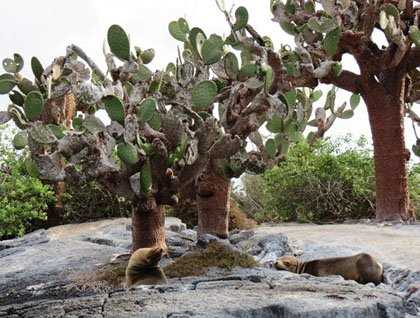One of the southern-most islands of the Galápagos, Floreana has been closely linked to the human history of the archipelago. It has an almost-permanent spring, so in the past it was often visited by seafarers to procure fresh water, as well as giant tortoises for food. Today, Floreana is inhabited by a small number of residents that base their economy on agriculture and tourism on a small scale. We dropped anchor during the night by the northern tip of Floreana, off the coast of Punta Cormorant. This site is very interesting as it holds a brackish lagoon that is a favorite hangout for the local greater flamingos. This native species feeds on the minute shrimp that inhabit the brackish waters, providing them with the necessary carotenoid pigment that gives the flamingos their characteristic color. We landed early in the morning at the beautiful olivine beach of Punta Cormorant in order to visit the flamingo lagoon; there, we spotted several adults and a few younger individuals, proving that the present breeding season has been a success. Not far from our landing spot there were several blue-footed boobies; it was fun to watch them perform their famous ‘booby dance’ or courtship ritual. The walk at Punta Cormorant is rather pleasant as it crosses a forest of ‘palo santo’ trees, most of which have already lost their foliage. At the end of the walk we arrived at the ‘flour’ beach, which is the perfect nesting site for the only sea turtle that breed in the islands: the Eastern Pacific green sea turtle.
Later in the morning we moved anchorage to Champion Island. This little island is full of life, with plentiful sea birds; it is also home to some of the last Floreana mockingbirds, of which we were able to see several during our Zodiac ride. Afterwards, it was time to enjoy the underwater world of Floreana, so we went snorkeling along its shoreline. The young Galapagos sea lions were most cooperative today, making everyone laugh with their fun pirouettes as they swam circles around the snorkelers. The fish life is exuberant in Champion, amongst which we found the razor surgeonfish, Panamic sergeant majors, damselfish, and even white-tipped reef sharks and spotted eagle rays.
We moved to another anchorage in the afternoon, not too far from Punta Cormorant. This place is called Post Office Bay, and it was first established possibly in the late 1700s or early 1800s by whalers in order to keep a mailing system to communicate with their home countries. In modern times, it is used by the many visitors who continue the tradition of depositing postcards in the barrel and taking mail left there that will be hand-delivered to its rightful owner.
Not far from the landing beach there is a group of islets known as La Lobería. Some of our guests had a chance to kayak along the rocky shoreline, while others joined the Zodiac rides that would take them close to La Lobería. When we approached the sea lion colony that lives in La Lobería we were pleasantly surprised to see how curious the young pups were, following us and leaping out of the water. These are shallow waters and many sea turtles come here to feed or rest from their long journeys, or perhaps to rest after the egg-laying season.
This was certainly another fabulous day, and we can’t wait to begin a new day in Las Encantadas.







